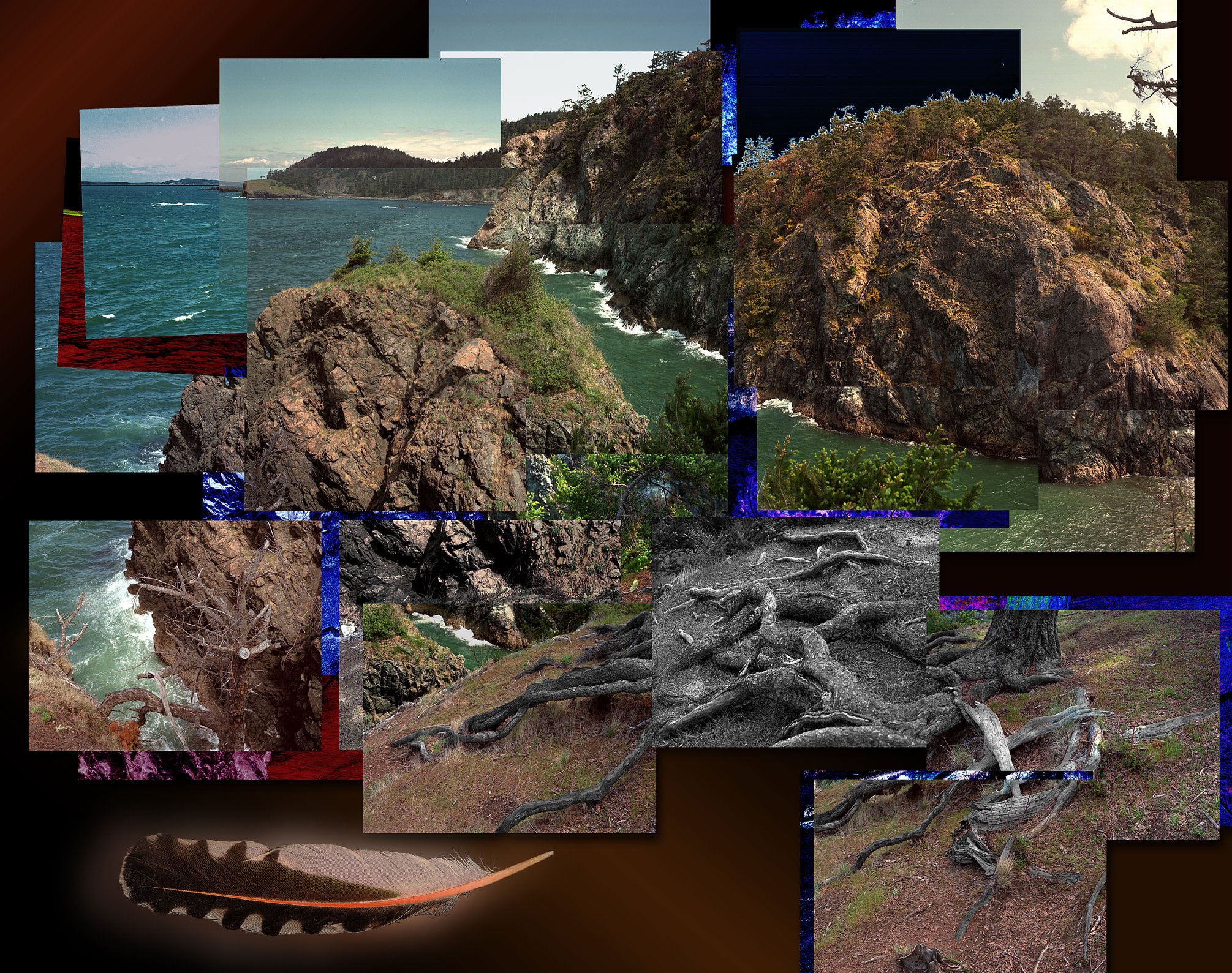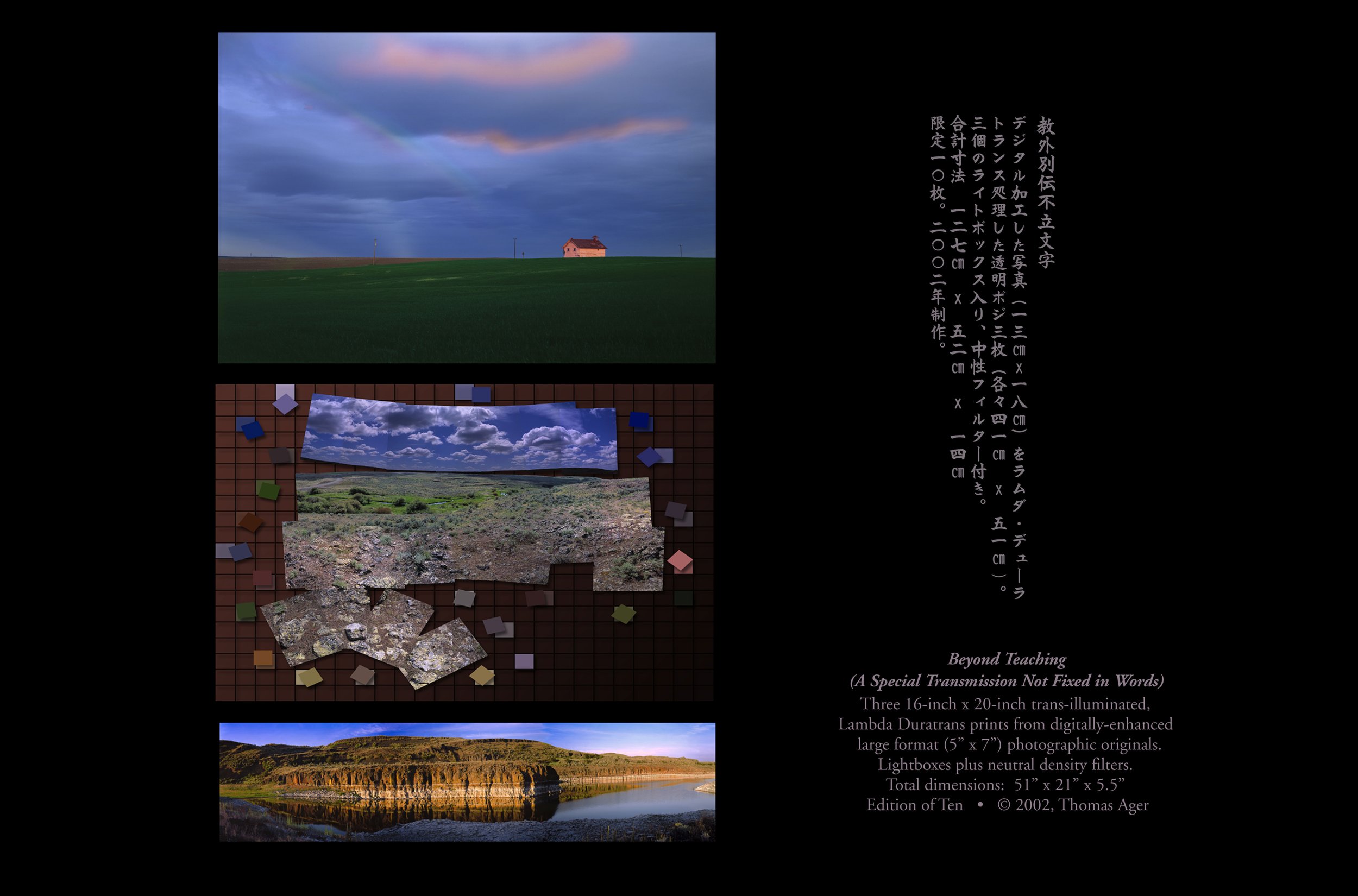Totem Lucida











































































TOKONOMA / LUCIDA and TOTEM / LUCIDA is a 2-part landscape project that I began working on in earnest in 1990. Essentially “lightbox art” I utilized laser technology to image my digital files directly onto photographic substrates in the creation of 2-dimensional trans-illuminated artworks.
Over the years I responded to my favorite Northwest landscapes with
this two-dimensional visual art plus exegetical dynamic media (that’s ArtSpeak for DVD/video).
Using the common ground of
advanced digital synthesis (more ArtSpeak for countless hours at the computer),
I discovered that
two-dimensional artworks in traditional media
as well as
high-end DVD motion video, soundscapes, and photography
can readily commingle and multiply into surprising new lifeforms
when allowed to bathe together in the digital bit-stream (especially in gallery/museum settings where sexy ArtSpeak is spoken).
For over 25 years I studied, recorded, photographed, drew and painted (plein air) two important, contrasting Northwest eco-regions (shrub-steppe/desert and coastal/marine). These two ecosystems exhibit dramatically different palettes, biomorphic shapes and lifeforms, weather, geology, and moods, as well as unique and complex interactions with their respective human communities. I responded to this inherent multiplicity with a highly-crafted, patiently developed, multi-disciplinary artistic approach.
The Tokonoma concept was given initial, extensive public exposure in the lobby of New City Theater (Seattle, Washington) in the early 1990s where I was video artist in residence. (I will always be grateful for the magnificent vision of the great impresario John Kazanjian, artistic director of the theater, his wife actress Mary Ewald and the entire crew. It was an incredible ride!) I received funding for this project from a variety of sources including the National Endowment for the Arts, King County Arts Commission and Artist Trust as well as a federal (BLM) grant.
The Lucida imagery is conceptually conjoined in two ways:
a) By subject matter, i.e. Landscape (primarily the shrub-steppe and coastal/marine ecosystems of the Northwest). My artwork explores the aesthetic component of these "e-scapes", the theoretical interaction of the various media used to create the imagery, and the sometimes contentious cultural issues arising from the interactions of humankind with an ecosphere which is no longer pristine.
b) By a "shared facture" using Digital Media (e.g. digital enhancements of original art, creation of Lambda Duratrans transparencies in which laser technology imprints digital files directly onto photographic substrates, and archival giclée prints). A national video producer for 25 years by profession, I also produced both single and dual-channel DVD/digital video programs which functioned exegetically by introducing the fourth dimension to my two-dimensional expressions. The resulting contrapuntal interactions between different source imagery makes aesthetic sense when exhibited in the gallery/museum because the digital treatment is appropriate and not merely gratuitous.
I believe that my artwork is aesthetically compelling and engaging enough to obviate the need for verbal explanations. However, years ago I recklessly plunged ahead and gave idiosyncratic names to each type of imagery. The following description elaborates on some of the concepts that orbit around the artwork.
Tokonoma / Lucida (a quick definition): In Japan, where I spent formative years as a child, most temples and many traditional homes enjoy an architectural "picture alcove" where a hanging picture or scroll and a flower arrangement reflect the seasonal changes throughout the year. In my body of artwork called "Tokonoma / Lucida", as in the traditional Japanese tokonoma, nature imagery predominates and is placed in today's modern tokonoma: the digital lightbox, the video monitor.
Step one: I created paintings with seasonal motifs in traditional media such as acrylics, gouache, etc. Each painting relates to a specific Northwest eco-region and a particular month of the year.
Step two: These paintings are digitally "captured" and enhanced with high-end scanners, digital software and video equipment.
Step three: The digital graphics file is realized as a 30" x 40" archival, trans-illuminated, Lambda Duratrans lightbox painting (this is called a "Tokonoma / Lucida").
Step four: From the "Tokonoma / Lucida" for each month the corresponding "Video Tokonoma" is created. The Video Tokonoma is a one or two-channel DVD video experience filled with high-end, broadcast-quality recordings of the sights and sounds of the landscape. My focus is on the Northwest eco-region(s) which inspired the "Tokonoma / Lucida" for that month. I performed all of the field recording using my own professional gear and carefully shaped the programs in my digital video editing suite (thus obviating the need for grant support). The flow of the program is inspired and informed by - and incorporates details of - the paintings. Certain carefully selected details are actually digital iterations and manipulated elements which I call "motifs" and "arrays".
Totem Lucida: A stacked, vertical, lightbox matrix of digitally-enhanced 16" x 20" transparencies related to the "Tokonoma / Lucida" is also created. These luminous totems are called “Totem/Lucida” and, together with the video experience, act as an accompaniment to the biomorphic expressionism of the Tokonomas. This imagery, like the “Video Tokonoma” acts contrapuntally since it is usually more representational and, therefore, somewhat more "accessible". The images themselves are generated from large-format (5x7 view camera) photographs, graphic works in traditional media and through purely digital iteration / creation. (In the gallery above, the individual images follow each fully stacked composition.)
Please note that, though these artworks are most effective in the context of a dialogue in which they can genuinely amplify and potentiate each other, they are also designed to stand alone (in a purely aesthetic modality) within a given exhibition space.
I was trained at Pratt Institute in New York City, have received a number of prestigious awards and grants, have created complex public arts projects, and have participated in a wide variety of collaborations with nationally and internationally renowned artists.